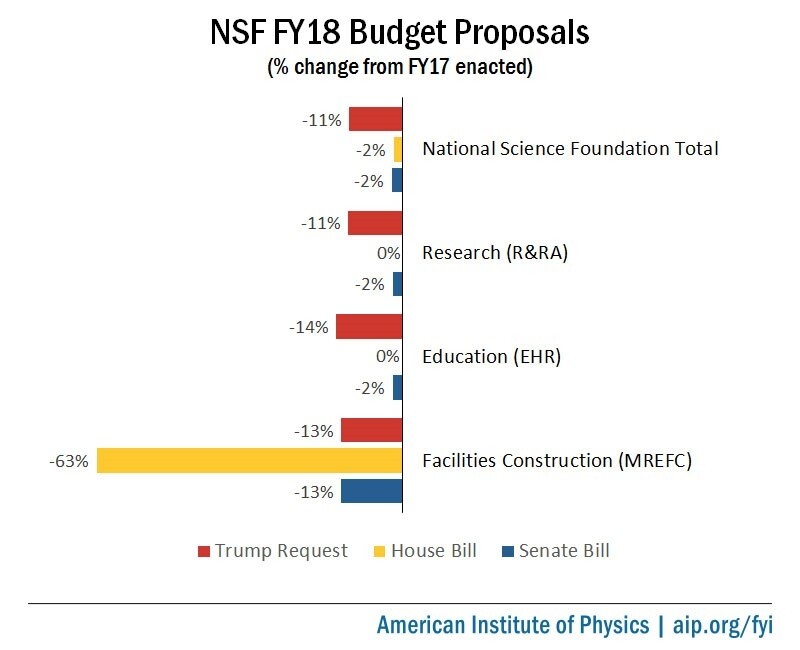
Senate Spending Bill Spreads Cuts Evenly Between NSF, NASA, NIST, NOAA
The Senate Appropriations Committee approved
At the July 27 full committee markup
The House CJS Subcommittee, which received an even lower allocation of $54.0 billion, approved
The Senate CJS Subcommittee, on the other hand, distributes its cut fairly evenly between agencies. Under the Senate proposal, each of the four research agencies would receive funding cuts of between 1 and 2 percent.
The charts below compare the current fiscal year 2018 proposals for the science agencies and other selected accounts funded by the CJS appropriations bill. Detailed tables containing funding figures for the science agencies and selected programs are available in FYI’s Federal Science Budget Tracker




Key senators agree budget caps constraining growth in science
In his opening statement

Senate Commerce, Justice, and Science Appropriations Subcommittee Chair Richard Shelby (R-AL) and Ranking Member Jeanne Shaheen (D-NH) touted their bipartisan collaboration that led to the fiscal year 2018 CJS spending bill.
(Image credit – Congressional Pictorial Directory)
The outcome is that NSF and NOAA would both receive 2 percent overall cuts, while NASA and NIST would receive 1 percent cuts. The proposed funding levels for the major research accounts within those four agencies would not stray far from their top lines either. While the NIST and NOAA research offices would both tick up 1 percent in the Senate bill, the NSF research account would see a 2 percent cut and NASA’s Science Mission Directorate (SMD) would see a 3 percent cut.
Within SMD, the Senate would hold Earth Science steady at fiscal year 2017 levels, rebuffing the deep and controversial cuts that the House and Trump administration have proposed for that division. Also, as it proposed last year, the Senate bill would deeply cut funding for Planetary Science.
Shelby’s longstanding support for NOAA is reflected in the bill, which rejects double-digit cuts to the agency’s research and satellite line offices proposed by the House and Trump administration. Shelby elaborated in his opening statement on these priorities, giving special attention to NOAA’s next generation weather satellites, including the Polar Follow On mission, a new program that will fund the procurement and launch of the third and four satellites in the flagship Joint Polar Satellite System. With respect to the National Weather Service, he was insistent the bill “does not support [the Trump administration’s] proposed cuts to weather operations, including NOAA’s National Water Center, which provides invaluable forecasts and services to the nation for water-related hazards.”
In her opening statement, Shaheen lamented the budget caps that are holding back overall growth in federal programs, saying they are precluding needed investments. She called on Congress to reach a bipartisan budget agreement to amend those caps and release more resources:
The bill could do more to invest in infrastructure, science, and law enforcement if we had a new budget deal that provided needed resources for both our military and other non-defense programs that protect America.
She emphasized, however, that the cuts to NSF and other research programs “do not reflect a lack of support for science” in the Senate but rather the “reality of our constrained budget caps.” It is a signal, she said, “that we need a new budget deal to address the destructive cuts due to sequestration.”
Shaheen amendment would infuse more funds into NSF, NASA
During the full committee markup, Shaheen offered an amendment to add $6.5 billion to the CJS allocation, which would have included $538 million to increase the NSF budget by 5 percent above the fiscal year 2017 level and maintain NASA Science at its fiscal year 2017 level. The amendment would also have invested more funds in STEM workforce programs.
Shelby, while expressing sympathy with Shaheen’s concerns and effort, ultimately opposed the amendment. He explained,
There are many programs [in the CJS bill] that deserve all of our strong support. Given the fiscal boundaries that have been set, I believe this bill does a good job of balancing the priorities of our committee members and the nation. But, if there is another budget agreement in the future, which we all hope we will have, I want to work with Senator Shaheen and others to discuss increases for programs in our bill that we all support, just as we worked together on the underlying bill before us. But since no such budget agreement has been reached, I would have to oppose this amendment.
Any further financial support for the science agencies in fiscal year 2018, beyond the levels already proposed in congressional appropriations, will hinge on the outcome of bipartisan budget negotiations that leaders of both parties are increasingly saying is needed.




